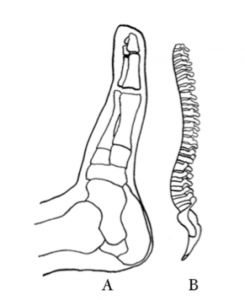Excerpt from Chapter 5 of my book Put Your Best Feet Forward.
The Relationship between the Arch of the Foot and the Spine.

The brilliant Dr. John Martin Hiss, MD, DO, was a very influential teacher in the development of my Structural Reflexology® practice. In his book New Feet for Old (1933), he eloquently describes how he learned the feet are designed very similarly to the mechanics of a clock, working in perfect tandem and precision. He remarked that the finely tuned and balanced clock would break and stop immediately from forceful pressures against its relationship of movement. This is not unlike the abused, bound foot. Unlike the clock, however, even if the mechanics of the foot break down, the brain will find another way to move the body. It will override normal foot function, and with the sheer willpower to get from here to there, draw on the energy of the larger muscles groups to move the body. Compensation then exhibits in posture changes, and neural and endocrine activity become confused.
In my thirty-five years of experience, I have observed and concluded that
the degree of curves in the arch of the foot are an exact blueprint of the degree of curves in the spine of any given individual, and every incremental movement the arch of the foot makes creates a catalyst of movement for each segment of the vertebrae during locomotion.
Because of this, one can isolate where tension in the back is brewing by assessing the tension in the arch of the foot, and vice versa, tension in certain areas of the spine can direct me to specific areas in the arch of the foot that have become tense.
The movement of the arch initiates a waving motion up the body and through the spinal column to the brain. This powerful energy produced by the unencumbered arch of the foot keeps the nervous system feeding efficient and appropriate signals to the muscles, glands, and organs, and fosters healthy blood and lymph flow throughout the body when walking.
When one chooses to impede the movement of the arch of the foot by wearing rigid, inflexible shoes, or worse, high heels, the arch of the foot becomes inert and will soon yield confusion in the muscles that move the feet and body because of their binding effect on the foot. These types of shoes cast the feet in an abnormal position, creating great strain on the foot and the rest of the body, and in particular, the spine.
The fallout from wearing any shoes that do not allow the feet to perform their normal function may never be traced to shoes. The feet are so adaptable to all sorts of abuse that functional foot disorders may brew for years before ever being detected or linked to the wearer’s past or present use of shoes.
In other words, shoes may covertly cause functional foot disorders and allow the foot to move without causing pain to the feet.
Chronic use of dysfunctional shoes, however, will create compensation throughout the rest of the body and communicate strain elsewhere. This may even cause degenerative issues difficult to trace back to the misaligned foot.
Structural foot disorders, on the other hand, speak to locked joints in the feet, which translates to locked joints throughout the body and actual foot pain. This condition is more overt and easier to assess because pain presents in the foot as slight to extreme foot-joint tension. Despite the pain, this can be a more fortunate scenario for those afflicted with foot problems as often the issue is addressed before compensation progresses into more serious degenerative issues.
Take some time and look at the profile of your feet. Can you see the similarities of the arch of your foot to the shape of your spine? If the arches of your feet appear high or low, the curves in your spine will reflect this. It’s truly a wonder!
Archives
- October 2024
- December 2023
- October 2023
- March 2022
- July 2021
- August 2020
- May 2020
- April 2020
- February 2020
- January 2020
- December 2019
- November 2019
- October 2019
- August 2019
- June 2019
- May 2019
- April 2019
- January 2019
- December 2018
- October 2018
- September 2018
- July 2018
- June 2018
- April 2018
- February 2018
- December 2017
- November 2017
- October 2017
- September 2017
- August 2017
- July 2017
- June 2017
- May 2017
- April 2017
- February 2017



2 Responses to It just makes sense!